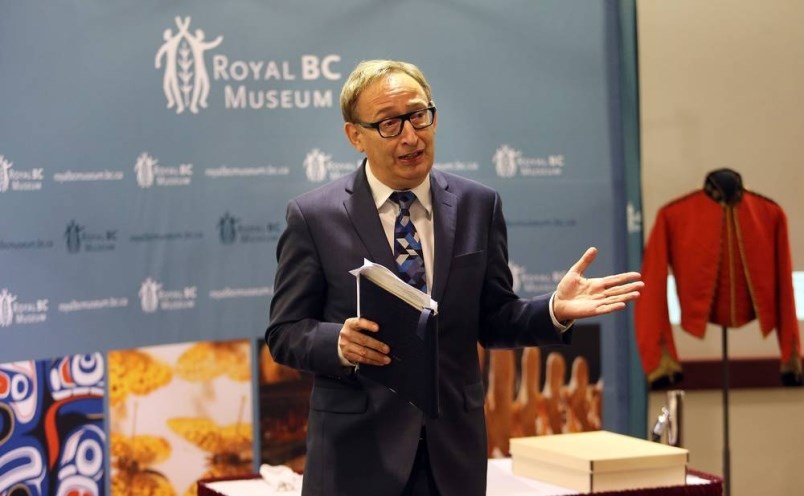The CEO of the Royal B.C. Museum announced to staff Tuesday he is resigning, two months after a diversity and inclusion consultant deemed the institution a “dysfunctional and toxic workplace, characterized by a culture of fear and distrust.”
Jack Lohman, hired as CEO in 2012, wrote in an email to staff that the museum needs “new energy and fresh leadership.” He said his resignation is a joint decision with the museum’s board.
In a statement, the museum said the board of directors and Lohman discussed how to address “current internal issues” and agreed his departure would be in the best interests of the organization. His last day will be Feb. 12.
Board chairman Dan Muzyka will be acting CEO until the museum hires Lohman’s replacement.
“It will be hard walking out the door as I care so very deeply about the museum and about making it forever better,” Lohman wrote in his email. “And my enthusiasm has never been stronger for our work and the many calls for greater social accountability.”
The museum is the subject of a months-long investigation after the former head of the Indigenous collections and repatriation department resigned in July, citing a culture of racism and discrimination.
In a July 24 farewell speech, Lucy Bell, a member of the Haida Nation, called out colleagues and executives, listing examples of racist comments directed at her during her time at the museum. She said her experience reflected both systemic racism and racism at an individual level. “It’s also outright discrimination, white privilege, bullying and micro-aggressions happening here, that happen every day,” she wrote in her speech.
Bell said news of Lohman’s resignation was bittersweet.
“I am sad that it had to come to this. I watched the RBCM board being cautious and thoughtful, and I know they have taken my concerns seriously and that their recent decisions must have been hard to make. I hope to see more positive changes in the museum and heritage field,” she said in an email.
When she started at the museum, she thought she would bring positive change for Indigenous people, said Bell, who is a founding member of the Haida Heritage and Repatriation Society in Haida Gwaii. She has co-ordinated the repatriation of more than 500 Haida ancestors from museums around the world.
“I thought I would leave a different legacy. If this is the work at the RBCM that I am known for, so be it,” Bell said.
The museum responded to the concerns Bell raised in July by initiating a B.C. Public Service Agency investigation and hiring diversity and inclusion consultant Alden Habacon, who conducted a survey of staff and volunteers in September focused on “inclusion and psychological health and safety.”
An analysis of 221 responses, representing about 73 per cent of staff and 14 per cent of volunteers, was presented to staff in early December.
In slides shown to staff and viewed by the Times Colonist, two themes were identified: poor leadership and management, and “individual and structural discrimination” and tokenism.
Sixty-four comments indicated staff had experienced bullying and abuse from management, and 18 responses called Lohman “an ineffective, indifferent, and elitist leader.”
Thirty-six people also indicated they did not trust management or human resources.
In the survey, 65 people said they see the museum as a “racist, anti-Indigenous and colonial space,” and 28 people called it a sexist space for women.
“Discrimination against and lack of support for marginalized groups make the RBCM and its cultural efforts feel inauthentic,” one slide said.
Stephanie Smith, president of the British Columbia Government and Service Employees’ Union, said the union stands behind its members in fighting for a workplace free of discrimination. “We’re really hoping that these senior leadership changes lead to the changes that our members have been calling for, which is a safe, healthy, inclusive worksite,” she said.
Melanie Mark, minister of tourism, arts, culture and sport, said in a statement the museum is working on modernizing its workplace culture and becoming a safe and inclusive place to work. “I hope that a change in leadership will contribute to helping the museum heal and develop a more culturally safe and inclusive work environment,” she said.
To address racism and discrimination at the museum, it is reorganizing the executive structure, improving the process for people to report harassment and discrimination, and implementing new training programs focused on trust building.
The museum will provide additional resources to the Indigenous collections and repatriation department, including several new positions, Muzyka said in late January.
In January, museum staff were made aware of the departures of Joanne Orr, deputy CEO and vice-president of collections, research and international programs, and Erica Wheeler, head of collections care and conservation, although board chair Muzyka would not say at the time whether they were related to the ongoing investigation or survey results.
Before joining the museum in 2012, Lohman was director of the Museum of London, beginning in 2002. From 1999 to 2002, he was CEO of Iziko Museums of Cape Town in South Africa, an organization of 15 national museums that includes the South African Museum, the South African Maritime Museum and the South African National Gallery.
Lohman and Muzyka were not available for interviews Tuesday.




